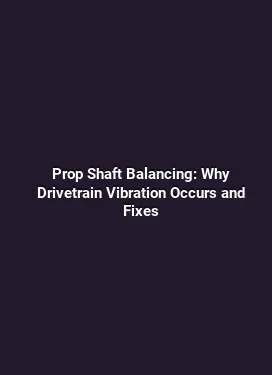How to Master Heel-Toe Downshifting for Manual Transmissions
Heel-toe downshifting is a skill that separates smooth, controlled driving from abrupt shifts that disrupt traction and balance. This technique blends precise footwork with clutch control to match engine speed to the lower gear, enabling clean, stable corner entry and confident highway overtakes. While it requires dedicated practice, a structured approach can translate into tangible on-road performance gains, improved driving comfort, and better vehicle control across a wide range of road conditions.
Makale içindeki ilk H2 başlık buraya gelmeli

At its core, heel-toe downshifting is about three core elements: pedal orchestration, metered clutch engagement, and accurate engine speed matching. The pedal orchestration involves a coordinated motion where the right foot simultaneously operates the brake and accelerator while the left foot manages the clutch. The goal is to raise engine speed (rev matching) just enough to smoothly engage the lower gear when the brake is applied. This requires a mental map of your particular gearbox, transmission gearing, and the engine’s torque curve. Drivers who practice with a consistent reference—such as a fixed target rpm increase per downshift—tend to achieve cleaner transitions over time.
Consistency comes from understanding that every vehicle behaves a little differently. Some manuals respond to heel-toe with a quick, precise blip of the throttle, while others demand a more measured, deeper intake to reach the same target. Observing the car’s response during braking, listening for the engine note, and feeling the transmission’s gear engagement are all part of reading the vehicle’s feedback. As with any advanced driving technique, initial attempts may feel awkward, but structured practice sessions quickly reduce the learning curve.
Makale içindeki ilk H2 başlık buraya gelmeli
Understanding the gear ratios and the engine’s torque band is a practical prerequisite for successful heel-toe. In most manual transmissions, downshifting is not merely about engine braking; it is about maintaining tire contact and brake balance while transitioning to a lower gear to handle corner exit or a rapid deceleration. Before attempting heel-toe in traffic, build a mental map of your car’s behavior: how quickly the engine revs rise, how fast the clutch disengages, and how the gearbox synchronizes after a shift. A well-prepared driver will anticipate changes in road surface, curb presence, and other drivers’ actions so that the downshift happens well in advance of the apex or highway merge points.
Practical preparation includes ensuring the vehicle’s drivetrain and throttle response are consistent. If the car has a foot-operated parking brake interlock or a lightweight, responsive throttle pedal, the feel becomes easier to measure and repeat. Practicing in a controlled environment—such as a quiet track or wide-open space—helps develop a repeatable muscle memory. The endgame is a fluid motion where the brake, throttle, and clutch work in harmony, producing a seamless transition that maintains vehicle stability and driver confidence.
Makale içindeki ilk H3 başlık buraya gelmeli

Footwork fundamentals start with a stable seat position, relaxed ankle motion, and natural leg alignment. The pedal layout should invite a corner of the right foot to rest on the brake while the ball of the foot can pivot to the throttle without lifting the heel excessively. A common cue is to anchor the heel lightly on the floor or a fixed point so the foot can pivot between brake and gas with minimal lateral movement. For many drivers, the critical moment is the initial brake application: a firm, progressive brake pressure sets the stage for a precise throttle blip that brings engine speed into the target range for the lower gear. The other anchor is smooth clutch engagement. When the throttle blip is timely, the clutch can engage without a jolt, and the vehicle will settle into the new gear with minimal pitch or yaw changes.
Developing a repeatable rhythm requires rhythm practice: drive at controlled speeds where braking into a corner becomes predictable, then repeat the downshift sequence until the timing becomes second nature. Feedback loops—watching the tachometer, listening to engine tone, feeling the transmission’s engagement—are crucial. Not every downshift will land perfectly on the first attempt, but a consistent practice routine helps dial in the exact engine speed required for a clean blend between revs and gear engagement.
Fundamental Techniques and Steps
Successful heel-toe downshifting is built on a clear sequence of actions that can be practiced in isolation before integrating into real driving. The steps can be described as a choreography: brake with the right foot, blip the throttle to match revs, depress the clutch with the left foot, shift to the lower gear, release the clutch smoothly, and reapply throttle for balance as the car settles in the new gearing. The key is to execute each action within a narrow time window so that the engine speed aligns with the transmission’s gear ratios. When done correctly, the transition feels almost invisible, with the car maintaining its trajectory through the corner or into the acceleration lane.
Throttling rhythm and brake pressure are two variables that drivers adjust to their vehicle. Some engines demand a quicker blip to meet the lower gear’s engine speed; others require a slower, more gradual rev increase. The dynamics of the brake and throttle interaction define how smoothly the car will decelerate while preparing for the shift. Practitioners should also consider the clutch characteristics: a light, quick pedal movement can aid rapid engagement, whereas a heavier clutch may introduce a perceptible delay or a harsher engagement. Each car model has its own personality, and the objective is to learn its signals through deliberate practice rather than relying on memory alone.
Back-to-back drills—downshifting from 4th to 3rd on a straight, then from 3rd to 2nd while approaching a corner—help build muscle memory. Recording sessions with a dash-mounted tachometer or data telemetry can reveal subtle timing differences in throttle blips and clutch release that may be imperceptible in real-time. The practice payoff is not just in smoother shifts but also in reduced braking loads and improved corner exit grip, because rev-matched downshifts minimize drivetrain yaw and transfer momentum more predictably.
Makale içindeki ilk H3 başlık buraya gelmeli
In practice, aiming to maintain steering balance through the corner is a primary reason for mastering heel-toe. When the lower gear is engaged with rev matching, the engine braking helps steady the car, reducing the need for abrupt brake inputs that could upset the chassis alignment. This control is particularly valuable on damp surfaces or in vehicles with moderate understeer characteristics, where abrupt loading changes can push the car wide. Drivers who consistently execute clean downshifts notice more confident corner entries and a steadier line through the apex, especially on twisty roads where precision matters more than outright speed.
Additionally, heel-toe compatibility depends on pedal spacing and the car’s pedal feel. In some modern performance cars, the throttle is very sensitive, and the clutch travel is short, which makes precise blips easier. In others, pedal travel is longer and less forgiving, requiring a more deliberate, measured approach. Understanding the specific pedal geometry of the vehicle you drive allows you to tailor your technique and avoid common issues such as blade-like throttle application that can cause over-revving or under-revving after the shift.
Car Setup, Gearbox Characteristics, and Driving Contexts
Transmission type strongly influences how heel-toe is executed. Manual gearboxes with well-matched ratios and a smooth clutch can deliver a nearly seamless rev match with a confident pedal response. The torque curve also plays a role: engines with broad, flat torque bands give more latitude for throttle blips, whereas high-revving units may require rapid rev increases to hit the target engine speed. A practical rule of thumb is to select a gearing and engine speed that keeps the revs within the engine’s sweet spot for the next gear—neither too high to cause overspeed nor too low to hinder acceleration after the shift.
Vehicle setup includes tires and brake balance. Stiffer suspensions or aggressive tires alter the way grip is distributed during braking and mid-corner throttle application, which in turn affects how aggressively one can perform a heel-toe shift. On a track, where cornering forces and load transfer are predictable, heel-toe can be extraordinarily precise. On public roads, it’s essential to balance performance with safety and comfort, ensuring that the technique remains controlled and repeatable under varying conditions like rain, uneven pavement, or light traffic.
Gearing strategy also matters. In vehicles with taller final gears, downshifting from fourth to third or even second might be necessary earlier to maintain acceleration on a line that leads into a corner. Conversely, in a car with shorter gearing, rev matching might be a simpler task in everyday driving. The broader concept is to anticipate the upcoming acceleration or braking event and plan the downshift so that it complements the car’s available torque in the new gear, rather than forcing the engine to fight against the wheels during corner entry or exit.
Makale içindeki ilk H3 başlık buraya gelmeli
Advanced drivers often pair heel-toe with additional techniques, such as gradual throttle modulation during the downshift to prevent abrupt momentum changes. This involves not only matching engine speed but also smoothing torque delivery in the lower gear as the clutch re-engages. The result is a hold on the steering wheel with minimal yaw, allowing the vehicle to settle gently into the corner. Practicing this blend in different environments, such as wet or slippery pavement or gravel, teaches drivers how to modulate pressure and timing to maintain stability even when grip is compromised.
Another practical angle is to integrate heel-toe with heel-toe-friendly braking techniques. For example, progressive braking before the corner while preparing the downshift ensures that the car remains stable as it transitions to the new gear. This approach reduces the risk of abrupt deceleration that might unsettle the chassis, enabling smoother trajectory control and more consistent lap times or road performance.
Practice Drills, Real-World Scenarios, and Drivetrain Etiquette
Structured practice is the fastest route to mastery. A recommended progression begins with isolated pedal work—practicing throttle blips while stationary, then progressing to light braking with a simulated downshift on a straight. Once the feel becomes familiar, combine these actions while moving at modest speeds, selecting an empty road or a track day session to reduce external pressures. The goal is to build repeatable sequences that you can deploy without conscious thought when it matters most.
In real-world driving, heel-toe should be employed as part of an overall driving strategy that prioritizes smoothness and predictability. When merging onto a highway, entering a corner at a moderate speed, or downshifting for a passing maneuver, a well-executed heel-toe can preserve direction and balance. The technique is not about forcing speed through a corner but about optimizing the vehicle’s response so that steering input, torque delivery, and braking are aligned toward a controlled outcome.
Advanced practitioners also explore throttle lift-and-blip variations that are less aggressive but equally effective. By maintaining consistent brake pressure while integrating a precise throttle blip, the engine’s RPM can be raised smoothly enough to prevent drivetrain shock. This approach is especially useful on cars with clutches that exhibit a longer engagement range or slower response to pedal input, where a steadier, more measured blip minimizes the risk of a mis-timed engagement.
Makale içindeki ilk H3 başlık buraya gelmeli
Practical tips for daily driving include recording practice sessions with a mounted camera or onboard telemetry to review downshift timing and clutch feel. Observing gear engagement on film can reveal subtle issues such as late clutch release or inconsistent throttle blips that might go unnoticed during a live drive. Over time, these observations translate into more precise downshifts, better engine braking, and a more composed driving experience in a broad range of scenarios.
As with any skill, there are common pitfalls to avoid. Being too aggressive with throttle blips can lead to engine overspeed in the lower gear, while delaying the clutch release might cause a hesitant or jerky shift. The middle ground is a fluid, controlled sequence that preserves balance and traction, ensuring that the vehicle remains planted through the corner and ready for the next maneuver.
Maintaining Transmission Health with Heel-Toe Practice
Regular heel-toe practice should be complemented by transmission health awareness. Smooth engagement reduces wear on synchronizers and helps prevent unnecessary clutch slip. Drivers who adopt a measured downshift cadence tend to generate less heat buildup in the clutch and gear train, extending component life and maintaining gear engagement quality over time. It’s also wise to inspect pedal linkages and ensure that the linkage play doesn’t introduce timing errors in throttle or clutch action. A well-maintained pedal assembly translates into more predictable pedal responses and a more repeatable shift experience.
In colder climates or during winter driving, engine and transmission temperatures influence downshift timing. Warming the car gradually and allowing the drivetrain to reach an optimal temperature window before aggressive heel-toe practice ensures reliable engagement and reduces the likelihood of clutch chatter or gear clash. When conditions are less than ideal, prioritizing smooth, conservative downshifts over aggressive timing helps protect the drivetrain and maintain control on slippery surfaces.
Finally, confidence grows from systematic practice across different vehicles or configurations. If you drive multiple cars with manual transmissions, note the differences in pedal feel, clutch travel, and throttle response. Maintaining a mental log of these variations helps you adapt quickly whenever you switch vehicles, preserving technique quality and safety in every driving context.






